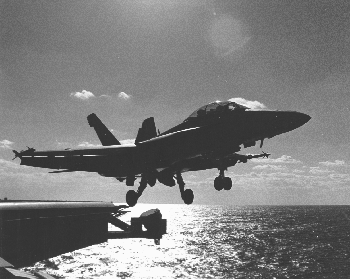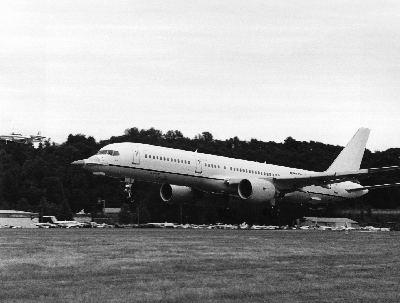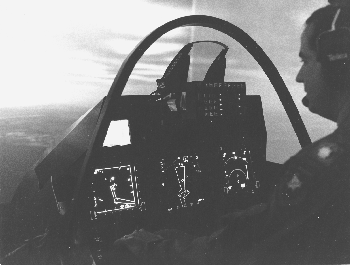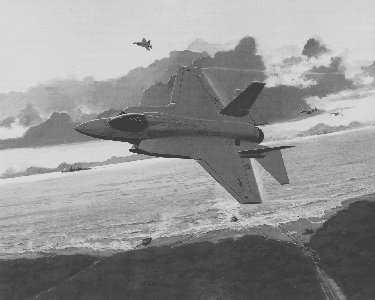
Graham Warwick/WASHINGTON DC
Lockheed Martin/Boeing's F-22 represents the pinnacle of US military-avionics development, but the air-superiority fighter is not scheduled to become operational until 2005. Meanwhile, manufacturers have begun development of the next generation of avionics, for the Joint Strike Fighter (JSF), which, probably optimistically, is scheduled to enter service in 2008. Bridging the gap between these programmes will be efforts to upgrade avionics installed in the current generation of fighters.
Programmes to upgrade the avionics in Boeing F-15s, Lockheed Martin F-16s and Boeing F/A-18s are important to the US military-avionics industry not only because they sustain development and production capabilities through the gap between fighter generations, but also because they promise to drive down the cost of certain technologies which are key to achieving the affordability goals set for the JSF. If these goals are not met, the programme will probably never emerge as envisaged today.
ACTIVE ARRAYS
The F-22 is the first US fighter to have an active electronically scanned array (ASEA) radar, the APG-77 developed jointly by Northrop Grumman and Raytheon. Instead of a mechanically driven flat-plate antenna, the radar has an array of some 2,000 transmit/receive modules. These are electronically scanned to create and steer agile beams, which allow search and track modes to be interleaved so that the F-22 pilot maintains situational awareness while the radar provides targeting information, all with a low probability that the APG-77's emissions will be intercepted by enemy sensors.
An active array was necessary in the F-22 to enable the radar to be integrated with the fighter's stealthy airframe. Eliminating the large swept volume required to accommodate a mechanically scanned antenna allowed the powerful radar to be installed in a forebody shaped for low radar cross-section - compare the radome size with that of the Boeing F-15. Inside the F-22's wide-bandwidth radome, the APG-77's active array is bolted to a bulkhead which is canted back to deflect radar returns. This also has the effect of increasing the look-up capability of the radar.
In a departure from previous fighter radars, signal and data processing is performed in common integrated processors (CIPs) which handle the same functions for the communication/- navigation/identification and electronic-warfare systems. Support electronics at each sensor send digitised waveforms via fibre-optic databus to the Raytheon-develop CIPs, where the data is fused to create coherent tracks for display to the pilot.
Boeing began flight-testing of a prototype APG-77 in its 757 flying tested in November 1997, following over a year of ground testing in a Northrop Grumman rooftop laboratory. The radar is installed in an F-22 forebody which has been attached to the nose of the 757. The aircraft is now being operated from Northrop Grumman's Baltimore, Maryland, plant to collect data to verify the radar performance model. Only the liquid-cooled radar and CIP are installed for these initial tests. In August, the 757 is scheduled to be returned to Boeing for installation of the other F-22 sensors, and integrated-avionics flight-testing is planned to begin in September. This will precede flight testing of the avionics suite in the fighter itself. The first radar-equipped F-22, the fourth of nine development aircraft, will not be flown until 1999.
Before then, beginning this May, the APG-77 will be exercised thoroughly in Boeing's F-22 Avionics Integration Laboratory (AIL) in Seattle. One of the 11 prototype radars to be built during the current development phase will be installed in the AIL tower at Boeing Field for early testing to identify anomalies before avionics flight-testing begins in earnest in the F-22. A Lockheed T-33 will be used as a calibrated airborne target, allowing data from the APG-77 to be compared with cross-section measurements now being made at Boeing's radar range.
A major part of the APG-77 development effort has been devoted to driving down the size and cost of the solid-state transmit/receive modules. That effort had made it possible to consider upgrading existing fighter radars with active arrays. The reasons for such an upgrade include increased capability and increased reliability: agile, electronically steered, beams allow near-simultaneous multi-mode operation; while radar performance degrades gradually with the failure of individual transmit/receive modules in the array.
Northrop Grumman is planning an ASEA upgrade of its APG-68 radar for the F-16C/D, dubbed the Agile Beam Radar (ABR). The APG-68ABR has been proposed for advanced F-16 versions offered to both Norway and the United Arab Emirates (UAE). Details are scant, but the APG-68ABR is likely to incorporate exciter, receiver and processor upgrades developed for the APG-68(V)X radar now being offered for the F-16. The upgrade increases reliability and reduces costs. The APG-68(V)X is to be available in 1999, a year ahead of the active-array APG-68ABR.
Raytheon Systems (formerly Hughes) has embarked, meanwhile, on a programme to upgrade its APG-73 radar in the Hornet which could see introduction of an active-array antenna soon after the improved F/A-18E/F enters service in 2001. The ASEA upgrade will build on hardware and software improvements, now in production, which give the APG-73 the ability to generate high-resolution ground maps comparable with those produced by the company's APG-70 radar in the F-15E and ASARS-2 in the Lockheed U-2. While the US Navy plans to retrofit the reconnaissance module to existing F/A-18C/D radars, the active array may be limited to new F/A-18E/Fs.
MODULE COSTS
Successful launch of ASEA upgrades for both the F-16 and F/A-18 radars should reduce the cost of active arrays and help JSF designers meet tough targets for avionics affordability. The JSF programme office hopes to reduce both acquisition and operating costs by increasing avionics integration beyond that achieved in the F-22. A key element of the planned JSF avionics suite is the multi-function integrated radio-frequency system (MIRFS). This is essentially a nose array combining radar, communication/navigation/-identification and electronic-warfare functions.
Hughes (now Raytheon) and Westinghouse (now Northrop Grumman) were awarded contracts in February 1996 to demonstrate a lightweight, low-cost, multi-function nose array (MFA). Ground tests of competing MFAs will begin in 1998, leading to flight tests in late 1999.
So far, neither of the JSF concept-demonstration teams - led by Boeing and Lockheed Martin - have selected a MIRFS supplier, but Lockheed Martin and Northrop Grumman have agreed to fund a joint effort to flight-test the JSF avionics architecture, including the MFA. The Co-operative Avionics Testbed (CATB) project involves modifying Northrop Grumman's BAC One-Eleven with the sensors, processors and software for the proposed mission avionics. The aircraft will be equipped with the Raytheon (formerly Texas Instruments) integrated core processor selected by Lockheed Martin for its proposed JSF, which will handle all signal and data processing for Northrop Grumman's MFA, shared-aperture electro-optical/infra-red sensors and electronic-warfare system. CATB flight testing is scheduled for mid-1999. Boeing may flight-test its JSF avionics architecture in the 757 testbed.
INTEGRATED INFRA-RED
The F-22 is the first US fighter with a designed-in missile launch-detection (MLD) system, again because the stringent requirements of stealth demand an integrated approach. The MLD, developed by Lockheed Martin company Sanders, consists of conformal infra-red (IR) sensors mounted above, below and either side of the F-22's forward fuselage. They are the only IR sensors on the aircraft, as an infra-red search-and-track (IRST) system planned for the fighter was cancelled for lack of funds. Provision has been made for an IRST, however, which could be used to accommodate an IR targeting system in a potential precision-strike derivative of the F-22, considered a likely replacement for the USAir Force's F-15Es and Lockheed F-117s.
The threat posed by shoulder-launched, IR-guided, surface-to-air missiles which cannot be detected by traditional radar-warning receivers is spurring the development of missile-warning systems (MWSs). It has been calculated that 80% of combat-aircraft losses between 1958 and 1992 - and 75% of US losses in the Gulf War - were to IR-guided missiles, but most fielded self-protection systems provide warning of radar-guided threats only.
There is a bewildering array of systems already available or under development for retrofit to current fighters. Most available MWSs use passive ultra-violet (UV) sensors, but there are systems now under development incorporating "two-colour" IR sensors which are less prone to false alarms. The F-22 MLD, for example, uses a staring (non-scanning) two-colour IR sensor.
Available MWSs include the Cincinatti Electronics/Raytheon AAR-44, Northrop Grumman AAR-54, Lockheed Martin Sanders AAR-57 and Daimler-Benz Aerospace/Litton AAR-60. In development are two-colour-IR upgrades of the AAR-44 and AAR-57, and an advanced IRMWS from Northrop Grumman designated the MIMS-2000.
The imaging-UV AAR-54 is in production for UK and Australian helicopters and UK, US and Portuguese transport aircraft and is being flight-tested by Norway for possible use on mid-life update (MLU) F-16s. Six MWS sensors have been installed in two wing pylons for flight tests on the F-16 in January and February. The tests are being conducted by the Royal Norwegian Air Force, with data being supplied concurrently to Denmark and the Netherlands, which have expressed interest in equipping their MLU F-16s with the system.
The UK Ministry of Defence and US Special Operations Command have selected the AAR-54 as the sensor for the AAQ-24 directed IR-countermeasures (DIRCM) system under development by Northrop Grumman. Flight testing of the DIRCM began in the UK in late 1997.
Sanders' UV-based AAR-57 has been selected as the Common Missile Warning System (CMWS) for the US Air Force, Army and Navy, and as the sensor for the ALQ-212 Advanced Threat Infra-Red Countermeasures (ATRICM) system also under development by the Lockheed Martin company. Prototype-sensor flight tests were conducted in early 1997 on an F-15, and development testing is scheduled to get under way later in 1998, leading to initial production in 1999. The UK, meanwhile, has ordered the AAR-57 for integration with the GEC-Marconi Aviation defensive-aids system selected for its Westland/Boeing WAH-64D Longbow Apache attack helicopters.

TWO-COLOUR UPGRADE
Sanders is under US Navy contract to develop a two-colour-IR upgrade of the AAR-57. This is intended as the sensor for a fast-jet derivative of the ATIRCM, called the Tactical DIRCM (TADRCM). Whereas the ATIRCM, like Northrop Grumman's DIRCM, is a fairly bulky turret designed for installation on helicopters and transports, the TADIRCM is a low-drag unit suitable for use on fighters. The system has a faceted dome housing the gimballed optics for the laser jamming source.
Northrop Grumman, meanwhile, has begun development of the MIMS-2000, an MWS with two-colour-IR sensor designed to detect longer-range and longer-burning IR and radar-guided missiles. Development began in 1997 and is scheduled to be completed by the end of 1999, leading to availability in 2000.
At the same time that MWSs are gaining in popularity, more air forces are acquiring forward-looking infra-red (FLIR) targeting pods for their fighters. While the current generation of pods sees increasingly widespread service, upgraded and new systems incorporating higher-resolution "third-generation" FLIRs are under development.
Lockheed Martin has sold its LANTIRN navigation and targeting pods to the US Air Force and nine other nations operating the F-15 and F-16. The US Navy has bought pods to equip a number of Grumman F-14s modified for the precision-strike mission. The company has completed development of an upgraded LANTIRN 2000 incorporating a third-generation FLIR and diode-pumped laser-designator to increase both performance and reliability while reducing cost of ownership.
The LANTIRN 2000 upgrade is available for existing pods, as will be an advanced "Block 2" version of the Nite Hawk targeting pod produced by Lockheed Martin for the F-18. The US Navy, however, has selected Hughes (now Raytheon) to develop the Advanced Targeting Forward-Looking Infra-Red (ATFLIR) system for the F/A-18 and improved F/A-18E/F. The ATFLIR, to be operational by mid-2002, will incorporate a targeting FLIR - a third-generation mid-wave IR sensor using staring-array technology - and a GEC-Marconi-supplied navigation FLIR in the same pod. Although Lockheed Martin lost the F/A-18 ATFLIR competition, it is continuing development of its advanced Sniper targeting pod.
The only US fighter now equipped with an IRST, meanwhile, is the F-14D, which has a Lockheed Martin mid-wave system installed in a chin turret. The same system has been repackaged into a pod and is being marketed for the F-16. Integrated with the radar, an IRST provides passive target detection and tracking. This allows the radar to be used only to provide mid-course guidance updates to the AIM-120 medium-range missile, reducing the probability that emissions will be detected.
The connection between MWSs, FLIRs and IRSTs seems tenuous, until it comes to the JSF. In the drive for affordability, the programme is pioneering development of shared-aperture electro-optical/infra-red systems. These would allow the functions of missile warning, air-to-air search and track and air-to-ground navigation and targeting to be performed by a single set of passive sensors, reducing cost and weight.
Northrop Grumman has launched development of the Distributed Architecture Infra-Red System (DAIRS), intended for the JSF. This uses six conformal, staring-array, IR sensors, each with a 90í x 90í field-of-view, distributed around the airframe to provide 360í coverage. Information from the DAIRS sensors would be used for defensive IR search and track, missile-approach warning, low-altitude navigation, target cueing and bomb-damage assessment.
Unlike the IR sensors in an MWS or IRST, the DAIRS staring arrays would provide high-resolution imagery suitable for projection on to the pilot's helmet-mounted display (HMD). A 1,000 x 1,000-element focal-plane array will be required to provide both FLIR imagery and angle-of-arrival information for the MWS and IRST functions, says Northrop Grumman. With imagery from sensors distributed around the airframe displayed on the HMD, the JSF pilot will be able to "see through" the aircraft, the company points out.
Northrop Grumman is working under a US Navy concept-demonstration programme to flight-test the DAIRS, first in its One-Eleven testbed and then in a Boeing TAV-8B. The One-Eleven flights are scheduled for mid-1999, leading to TAV-8B flight demonstrations in the first half of 2001. The company, which is working with both JSF teams, estimates that a shared-aperture like the DAIRS could cost as little as $0.5 million, compared with $5 million for a separate MWS, IRST and FLIR.

RESOURCE SHARING
Resource-sharing is a feature of the F-22's communication/navigation/identification (CNI) and electronic-warfare (EW) systems, which share elements such as processing modules, power supplies and antennas in an effort to increase the integration of onboard and off-board sensor information and make best use of the apertures provided in the stealthy airframe.
Details of how the EW system operates are understandably scant and, anyway, it would be difficult to achieve the level of integration found in the F-22 in any existing fighter. CNI and EW upgrades for the F-15, F-16 and F-18 are therefore being pursued piecemeal.
The biggest effort under way is to improve the EW suites in existing fighters. Cancellation of the ITT/Westinghouse (now Northrop Grumman) ALQ-165 Advanced Self-Protection Jammer (ASPJ), intended as the common internal electronic-countermeasures system for all Air Force and Navy fighters, has left the US front-line forces somewhat vulnerable to missile attack. As a result, ASPJs have been installed in F/A-18s operating over Bosnia, and the system remains in production for Finnish and Swiss Hornets as well as South Korean F-16s.
Attention has now switched to the Integrated Defensive Electronic Countermeasures (IDECM) system, which is being developed by Lockheed Martin Sanders and ITT Avionics. This is intended as a substitute for the cancelled ASPJ and, in fact, uses several modules from the APQ-165. The big different, however, is that the IDECM is based on a towed radar decoy.
Towed decoys are becoming all the rage. Raytheon has developed the ALE-50 decoy which is to be installed on US Air Force F-16s and Rockwell B-1Bs. The ALE-50 is a relatively simple decoy which, once deployed, repeats the signal received from a hostile radar to draw the incoming missile away from the aircraft.
Sanders' ALE-55 fibre-optic towed decoy (FOTD) for the IDECM is a more-sophisticated system. Emitter information from the host- aircraft's radar-warning receiver is fed to a "techniques generator", mounted inside the aircraft, which creates deceptive-jamming signals communicated via wide-band fibre-optic cable to high-power transmitters in the towed decoy.
The IDECM is under development for the US Navy's F/A-18E/F and US Air Force's B-1B, F-1E and U-2. Flight testing is to begin early in 1998, with production scheduled to start in 1999. Lockheed Martin is interested in adapting the system to its F-16, and the ALE-55 is designed to be deployed from the same dispenser as the existing ALE-50 decoy, for ease of upgrade. Raytheon, meanwhile, is working on an FOTD upgrade to the ALE-50 which has been selected by the UK for its updated British Aerospace Nimrod 2000 maritime-patrol aircraft. This uses Northrop Grumman micro-wave power-modules in the towed decoy.
Few details have been released of the planned JSF EW system, other than that radio-frequency (RF) electronics will be shared, using common modules, integrated core processors, and shared apertures for radar, CNI and EW functions - the most important of which will be the already-mentioned multi-function nose array. The use of advanced towed decoys - possibly IR, as well as RF - seems likely.

COCKPIT DISPLAYS
The F-22's cockpit represents a substantial advance over anything flying today, particularly in its use of large-format liquid-crystal displays (LCDs). It does not, at the moment, include a helmet-mounted display, but one is scheduled to be installed before the aircraft enters service, to allow full use of the off-boresight capability of the improved AIM-9X dogfight missile under development by Raytheon.
The F-22 is one of the applications planned for the Joint Helmet-Mounted Cueing System (JHMCS) under development by Vision Systems International, a joint venture formed by Kaiser Electronics and Israel's Elbit Systems. The other initial applications will be on the USAF's F-15s and F-16s and the USN's F/A-18s, with production scheduled to begin in 2000. The initial JHMCS will be a monocular, monochrome display projecting symbology on to the helmet visor. The 20í display field-of-view will be suitable for off-boresight missile cueing in daylight air-combat. Apre-planned product-improvement programme addresses future system upgrades required for air-to-ground operations in the Boeing AV-8B, as well as the JSF.
The JSF programme office has already conducted flight tests, using a TAV-8B, to determine whether a wide-field-of-view HMD, coupled with three-dimensional audio and speech command, can reduce pilot workload and increase situational awareness sufficiently to allow the head-up display to be eliminated from the JSF cockpit. Results from the Integrated Helmet Audio Visual System demonstration have been fed into the JHMCS programme to ensure that the resulting helmet-mounted display can be integrated into the winning JSF design during the engineering- and manufacturing-development phase, which is scheduled to begin in 2001.
Source: Flight International


























